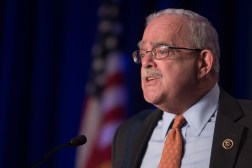The importance of the CIO-CFO relationship to FITARA
The effectiveness of the Federal Information Technology Acquisition Reform Act may ultimately come down to how well department chief information officers and chief financial officers can collaborate, senior agency officials argued Friday.
Despite the greater budget authority vested in CIOs by the law, panelists at the Association of Government Accountants’ annual CFO-CIO Summit said Friday morning that CIOs must not isolate CFOs with their new powers.
“What you don’t want is a FITARA implementation where somebody takes that guidance and the CIO goes off by themselves and implements … a redundant, duplicative, isolated budget approval process for IT,” said Lee Lofthus, assistant attorney general for administration in the Justice Department. Instead, he said, “it ought to be an integrated IT budget approval process where that CIO and the CFO” work closely with one another.
Passed as part of a larger piece of legislation late last year, FITARA gives more IT budgeting authority to department CIOs. Many of Lofthus’ federal colleagues who spoke at the summit echoed his sentiments on FITARA, and most said they’ve seen the centralized CIO model work well in their own agencies for years.
For instance, Lofthus’ Justice Department formed a central management division long before FITARA “that has all the CXOs in one division,” he said. “We made an effort to make sure that the CFOs and CIOs were working together.”
“The guy or gal who is going to help you the most accomplish what you need is going to be your CFO,” said Mark Reger, deputy controller in the Office of Management and Budget. “And to the extent that you know what’s important for them and to the extent that you can help them get their work done, the relationship will flower. We can accomplish a lot working together; we will accomplish very little if we don’t.”
Department of Veterans Affairs CIO Stephen Warren reasoned, “It’s not about control. It’s not about ‘It’s mine now, it’s payback time.’ It’s about how do we work together?”
VA for years has operated much like FITARA-era agencies will with one central CIO. Warren said he’s seen how this structure can be effective if the CIO collaborates with other leadership.
“It wasn’t something I did in the office in the dark,” he said. “The whole leadership was there, we talked about it, we did the trade-offs and then we made a decision going forward. That’s the spirit of FITARA.”
Department of Homeland Security CIO Luke McCormack told the audience the new law is really just “memorializing” good practices many agencies already follow. At DHS, McCormack meets informally with chief-level executives every morning to collaborate workflows.
“We work very closely with our CFO community in a variety of areas, and FITARA helps that,” he said. “But quite frankly FITARA really puts into law some of the things a lot of us were already doing and simply memorializes a lot of that.”
But for those agencies that don’t already collaborate that way, it could be a major struggle to adjust to FITARA.
“Agencies better grab this thing aggressively and get the right people in the room to come up with a plan to make this thing work,” Lofthus said. “FITARA, given the authorities it gives folks in that act, can be implemented in an agency in a way that’s going to, frankly, be detrimental. Or it could be implemented in a way that’s very, very beneficial to the agency. If you want the latter result, you’re going to have to get the right people in the room and put some real planning into a governance structure that makes this work.”
Not every agency is the same. Many come in different shapes, sizes and organizing structures. That’s why OMB and federal CIO Tony Scott released a draft guidance Thursday to help agencies adhere to the law.
“We’re not thinking of this as a one-size-fits-all sort of model,” Scott said at the event. “We’re encouraging people to go look at the common baseline, understand both the intent and the direction of this, and then where necessary, craft a plan in the spirit of all that makes sense and that embraces this notion.”
At its core, this law is about accepting the digitization of all the federal government’s business processes and breaking down the silo around the CIO so he or she can better align with those other agency operations for maximum success, he said.
“There’s nothing that you can do, there’s no business decision you can make that doesn’t have some huge technology implication or impact,” Scott said. “What FITARA does in this particular case is recognize the importance of the conversation of the people who manage the technology in an agency and the people who are making the business decisions, the policy decisions, the financial decisions and so on for that agency.”




